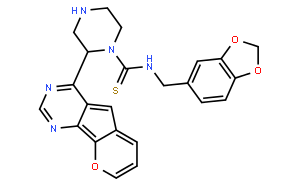| In vitro |
The hydrochloride salt of MP-470 also inhibits several mutants of c-Kit, including c-KitD816V, c-KitD816H, c-KitV560G, and c-KitV654A, as well as a Flt3 mutant (Flt3D835Y) and two PDGFRα mutants (PDGFRαV561D and PDGFRαD842V), with IC50 of 10 nM to 8.4 μM. MP-470 potently inhibits the proliferation of OVCAR-3, A549, NCI-H647, DMS-153, and DMS-114 cells, with IC50 of 0.9 μM–7.86 μM. [1] MP-470 also inhibits c-Kit and PDGFRα, with IC50 values of 31 μM and 27 μM, respectively. MP-470 demonstrates potent cytotoxicity against MiaPaCa-2, PANC-1, and GIST882 cells, with IC50 of 1.6 μM to 3.0 μM. MP-470 also binds to and inhibits several c-Kit mutants, including c-KitK642E, c-KitD816V, and c-KitK642E/D816V. [2] In MDA-MB-231 cells, MP-470 (1 μM) inhibits tyrosine phosphorylation of AXL. [3] In LNCaP and PC-3, but not DU145 cells, MP-470 exhibits cytotoxicity with IC50 of 4 μM and 8 μM, respectively, and induces apoptosis at 10 μM. In LNCaP cells, MP-470 (10 μM) elicits G1 arrest and decreases phosphorylation of Akt and ERK1/2. [4] In SF767 cells, MP-470 (10 μM) inhibits c-Met phosphorylation and sensitizes cells to radiation. In combination with radiation, MP-470 (10 μM) inhibits glycogen synthase kinase (GSK)3β activity, induces apoptosis, and disrupts the repair of dsDNA breaks probably through suppression of Rad51. [5] [6]
|

 COA
COA MSDS
MSDS HPLC
HPLC NMR
NMR